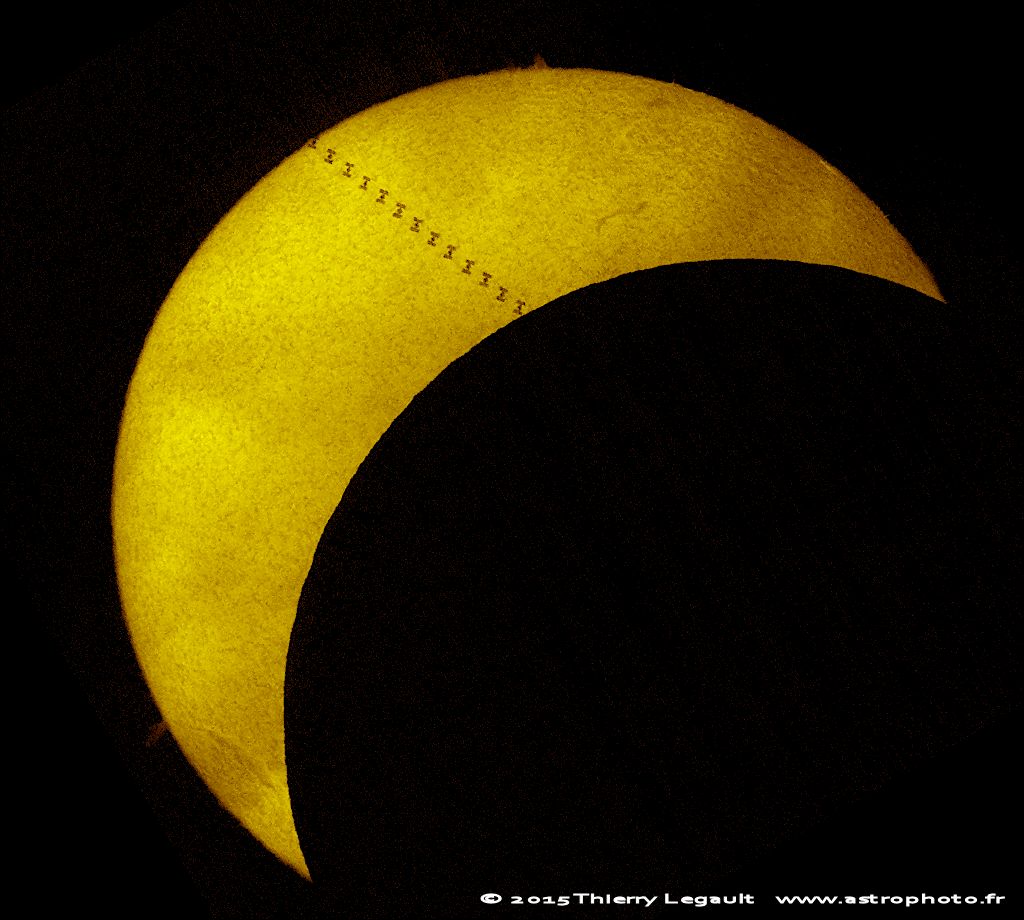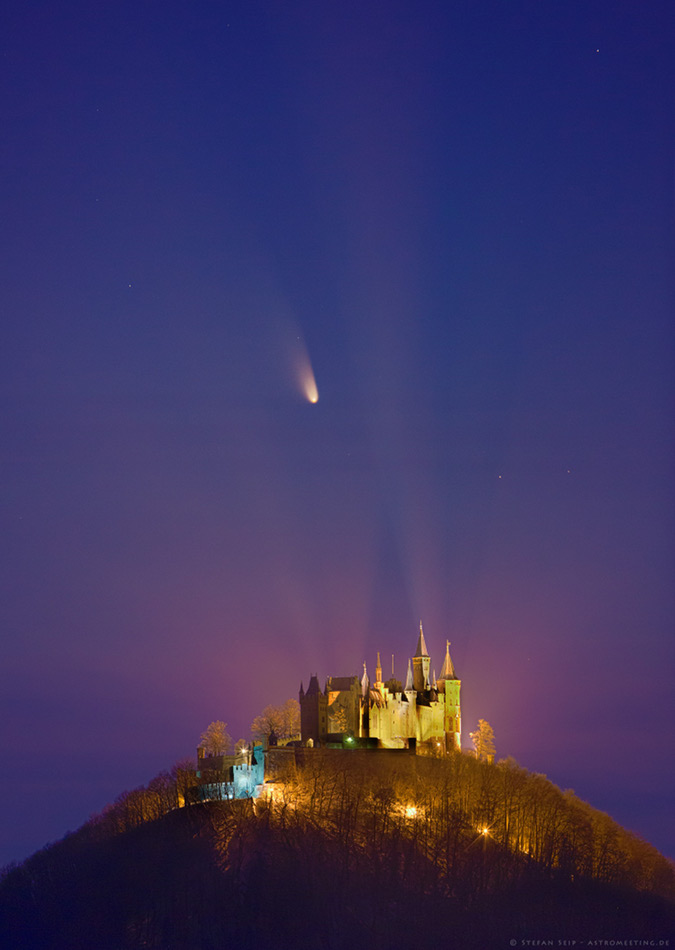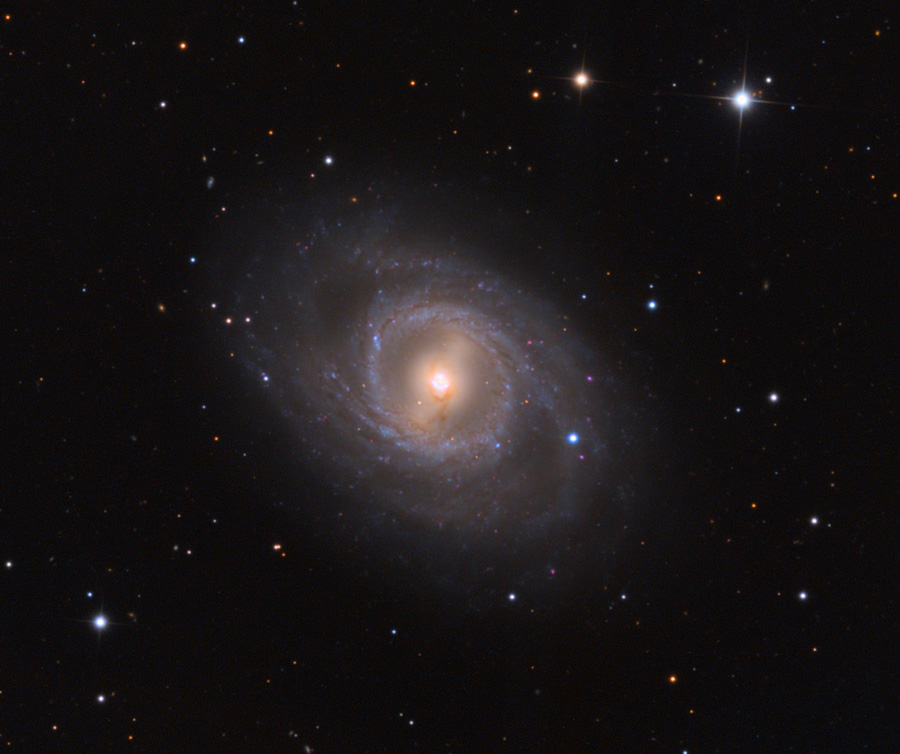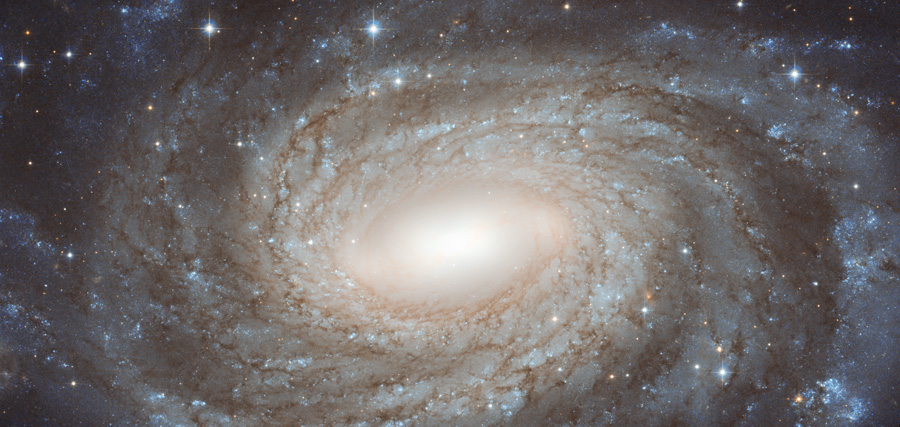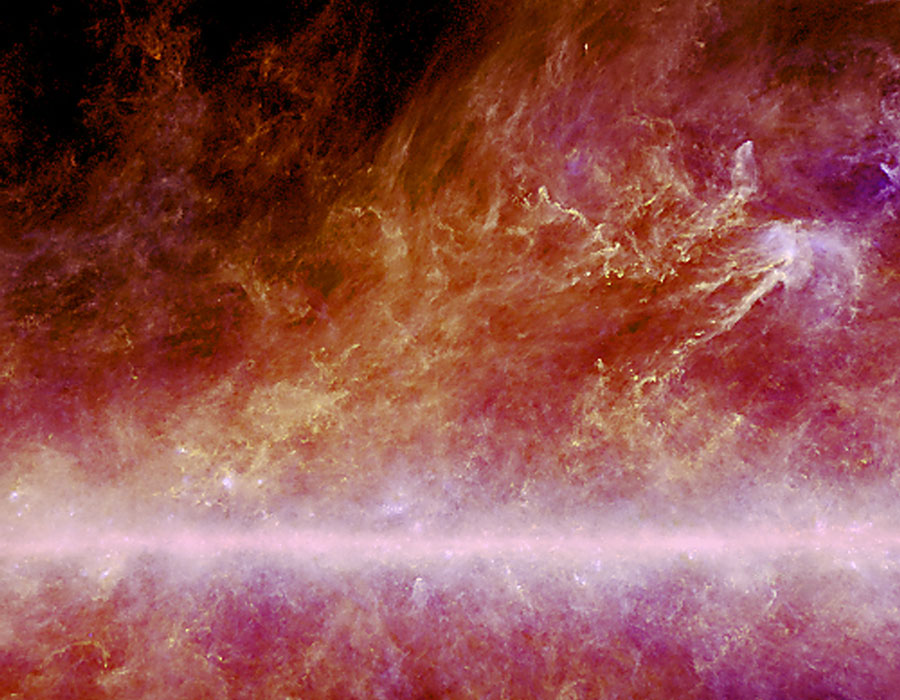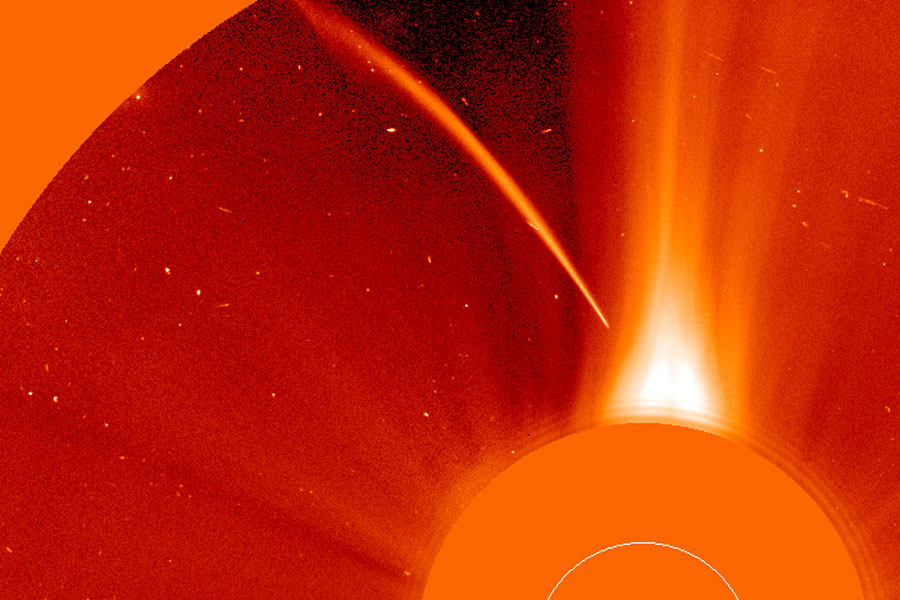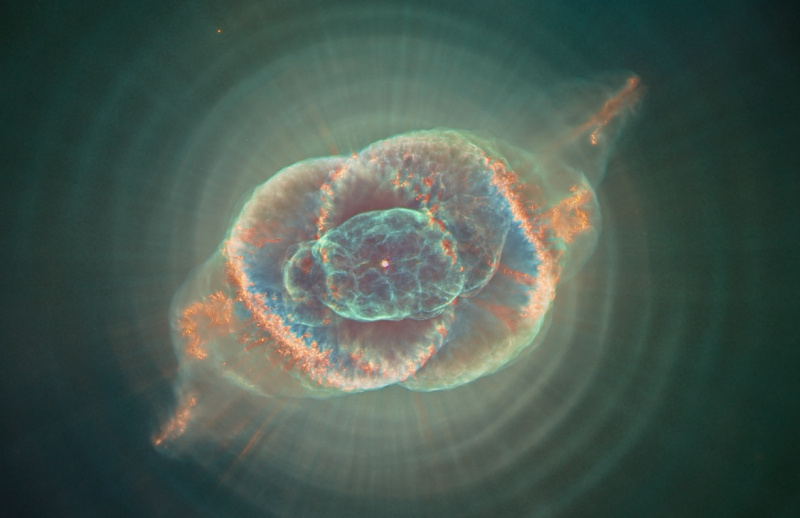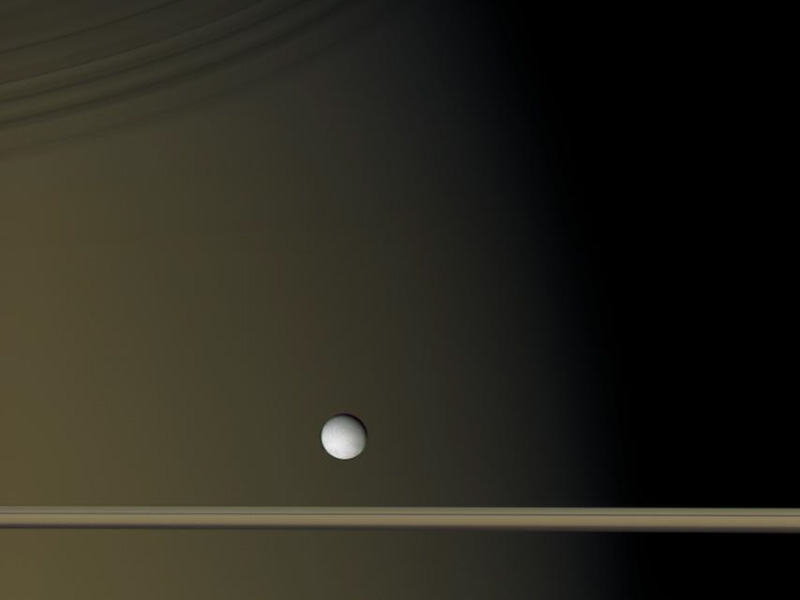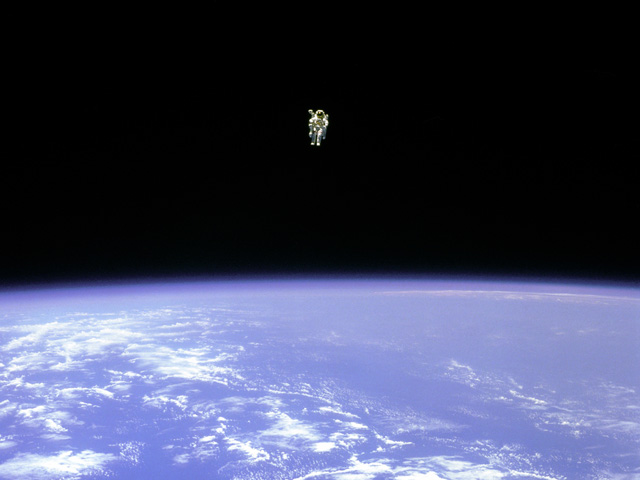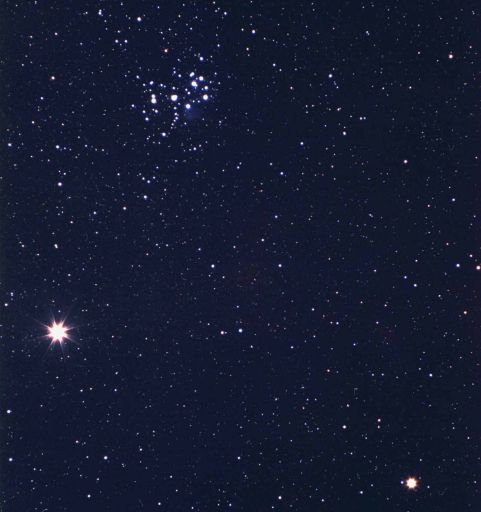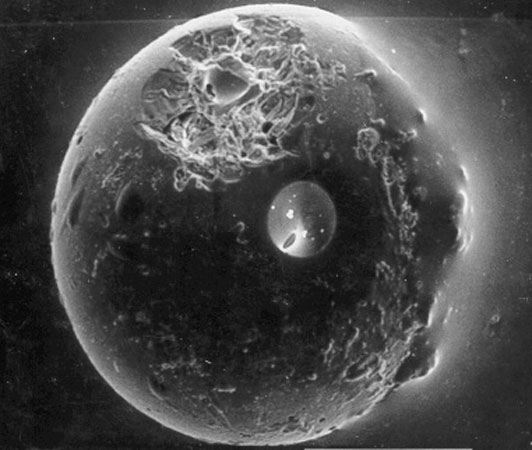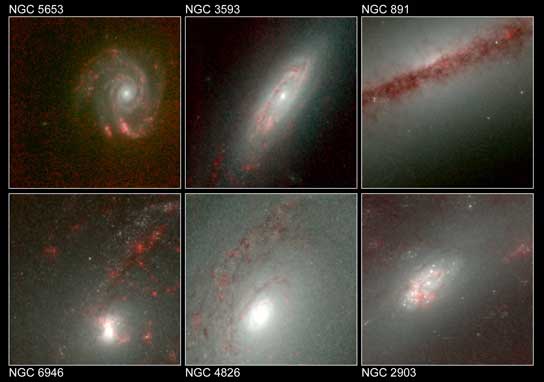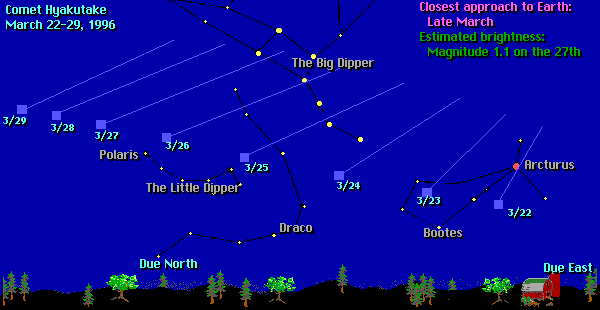APOD Retrospective: March 22
Posted: Thu Mar 22, 2012 3:20 am
| << Previous | Index | Next >> |
2015 Can the Sun be eclipsed twice at the same time? Last Friday was noteworthy because part of the Earth was treated to a rare total eclipse of the Sun. But also on Friday, from a part of the Earth that only saw part of the Sun eclipsed, a second object appeared simultaneously in front of the Sun: the Earth-orbiting International Space Station. Although space station eclipses are very quick -- in this case only 0.6 seconds, they are not so rare. Capturing this composite image took a lot of planning and a little luck, as the photographer had to dodge a series of third objects that kept, annoyingly, also lining up in front of the Sun: clouds. The above superposed time-lapse sequence was taken from Fregenal de la Sierra in southern Spain. The dark disk of the Moon dominates the lower right, while the Sun's textured surface shows several filaments and, over an edge, a prominence.
2014 Deep shadows create dramatic contrasts between light and dark in this high-resolution close-up of the martian surface. Recorded on January 24 by the HiRISE camera onboard the Mars Reconnaissance Orbiter, the scene spans about 1.5 kilometers across a sand dune field in a southern highlands crater. Captured when the Sun was just 5 degrees above the local horizon, only the dune crests are caught in full sunlight. With the long, cold winter approaching the red planet's southern hemisphere, bright ridges of seasonal frost line the martian dunes.
2013 The broad dust tail of Comet PanSTARRS (C/2011 L4) has become a familiar sight for many northern hemisphere comet watchers, as the comet fades but rises higher above the western horizon after sunset. This view of the popular comet may seem a little fantastic, though. Sweeping away from the Sun and trailing behind the comet's orbit, the curving dust tail also seems to stream away from a shining mountaintop castle. Comet Castle might be an appropriate name in this scene, but its traditional name is Castle Hohenzollern. Taken on March 15 with an extreme telephoto lens, the Comet Castle image was captured in exceptionally clear skies about 80 kilometers away from Stuttgart, Germany.
2012 Barred spiral galaxy M95 is about 75,000 light-years across, comparable in size to our own Milky Way and one of the larger galaxies of the Leo I galaxy group. In fact, it is part of a not quite so famous trio of Leo galaxies with neighbors M96 and M105, about 38 million light-years distant. In this sharp and colorful cosmic portrait, a bright, compact ring of star formation surrounds the galaxy's core. Surrounding the prominent yellowish bar are tightly wound spiral arms traced by dust lanes, young blue star clusters, and telltale pinkish star forming regions. As a bonus, follow along the spiral arm unwinding down and to the right and you'll soon get to M95's latest supernova SN 2012aw, discovered on March 16 and now identified as the explosion of a massive star. A good target for small telescopes, the supernova stands out in this video feature (vimeo) comparing the recent image with a deep image of M95 without supernova taken in 2009.
2011 The universe is filled with galaxies. But to see them astronomers must look out beyond the stars of our galaxy, the Milky Way. For example, consider this colorful telescopic view of spiral galaxy NGC 6384, about 80 million light-years away in the direction of the constellation Ophiuchus. At that distance, NGC 6384 spans an estimated 150,000 light-years, but this close-up of the galaxy's central region is about 70,000 light-years wide. The sharp image shows details in the distant galaxy's blue spiral arms and yellowish core. Still, the individual stars seen in the picture are all in the close foreground, well within our own galaxy. The brighter Milky Way stars show noticeable crosses, or diffraction spikes, caused by the telescope itself.
2010 What shapes the remarkable dust tapestry of the nearby Milky Way Galaxy? No one knows for sure. The intricate structures, shown above, were resolved in new detail recently in a wide region of the sky imaged in far infrared light by the European Space Agency's Planck satellite. The above image is a digital fusion of three infrared colors: two taken at high resolution by Planck, while the other is an older image taken by the now defunct IRAS satellite. At these colors, the sky is dominated by the faint glow of very cold gas within only 500 light years of Earth. In the above image, red corresponds to temperatures as cold as 10 degrees Kelvin above absolute zero, while white corresponds to gas as warm at 40 Kelvins. The pink band across the lower part of the image is warm gas confined to the plane of our Galaxy. The bright regions typically hold dense molecular clouds that are slowly collapsing to form stars, whereas the dimmer regions are most usually diffuse interstellar gas and dust known as cirrus. Why these regions have intricate filamentary shapes shared on both large and small scales remains a topic of research. Future study of the origin and evolution of dust may help in the understanding the recent history of our Galaxy as well as how planetary systems such as our Solar System came to be born.
2009 The Sun destroyed this comet. Arcing toward a fiery fate, this Sungrazer comet was recorded by the SOHO spacecraft's Large Angle Spectrometric COronagraph(LASCO) on 1996 Dec. 23. LASCO uses an occulting disk, partially visible at the lower right, to block out the otherwise overwhelming solar disk allowing it to image the inner 5 million miles of the relatively faint corona. The comet is seen as its coma enters the bright equatorial solar wind region (oriented vertically). Spots and blemishes on the image are background stars and camera streaks caused by charged particles. Positioned in space to continuously observe the Sun, SOHO has now been used to discover over 1,500 comets, including numerous sungrazers. Based on their orbits, they are believed to belong to a family of comets created by successive break ups from a single large parent comet which passed very near the Sun in the twelfth century. The Great Comet of 1965, Ikeya-Seki, was also a member of the Sungrazer family, coming within about 650,000 kilometers of the Sun's surface. Passing so close to the Sun, Sungrazers are subjected to destructive tidal forces along with intense solar heat. This comet, known as SOHO 6, did not survive.
2008 Staring across interstellar space, the alluring Cat's Eye Nebula lies three thousand light-years from Earth. One of the most famous planetary nebulae in the sky, the Cat's Eye (NGC 6543) is over half a light-year across and represents a final, brief yet glorious phase in the life of a sun-like star. This nebula's dying central star may have produced the simple, outer pattern of dusty concentric shells by shrugging off outer layers in a series of regular convulsions. But the formation of the beautiful, more complex inner structures is not well understood. Here, Hubble Space Telescope archival image data has been reprocessed to create another look the cosmic cat's eye. Compared to well-known Hubble pictures, the alternative processing strives to sharpen and improve the visiblility of details in light and dark areas of the nebula and also applies a more complex color palette. Of course, gazing into the Cat's Eye, astronomers may well be seeing the fate of our Sun, destined to enter its own planetary nebula phase of evolution ... in about 5 billion years.
2007 On Moonday, March 19, shortly before the equinox, locations in Asia and the Arctic were favoured by the New Moon's shadow during a partial solar eclipse. Although the view from Goa, India found the eclipsed Sun near the horizon, photographer Joerg Schoppmeyer was still able to capture this lovely image, combining celestial with terrestrial silhouettes. The next eclipse season will begin in late August this year, featuring a total lunar eclipse on August 28, and another partial solar eclipse on September 11. Compared to the March 19th eclipse, the September 11th eclipse will be seen on the other side of our fair planet, from parts of South America and Antarctica.
2006 Some images of Saturn appear surreal. Earlier this year, the robot spacecraft Cassini now orbiting Saturn took this surreal image of the gas giant Saturn, its majestic rings, and its enigmatic world Enceladus all in one frame. Enceladus, recently found to emit jets of ice from possible underground seas, appears white as its surface is covered with relatively clean water-ice. Below Enceladus are the rings of Saturn, seen nearly edge on. Compared to Enceladus, Saturn's rings show their comparatively high density of dirt with their golden-brown color in this natural color image. The planet Saturn, in the background, appears relatively featureless with the exception of thin ring shadows visible on the upper left. The terminator between night and day is seen vertically across the face of this distant world.
2005 At about 100 meters from the cargo bay of the space shuttle Challenger, Bruce McCandless II was further out than anyone had ever been before. Guided by a Manned Maneuvering Unit (MMU), astronaut McCandless, pictured above, was floating free in space. McCandless and fellow NASA astronaut Robert Stewart were the first to experience such an "untethered space walk" during Space Shuttle mission 41-B in 1984. The MMU works by shooting jets of nitrogen and has since been used to help deploy and retrieve satellites. With a mass over 140 kilograms, an MMU is heavy on Earth, but, like everything, is weightless when drifting in orbit. The MMU was replaced with the SAFER backpack propulsion unit.
2004 Last week, a small asteroid approached unusually close to the Earth. Asteroid 2004 FH posed no danger, but became bright enough to see with binoculars. Passing only 7 Earth radii away, this asteroid pass was the closest yet that was previously predicted, although it was discovered only two days before. Pictured above, the 30-meter sized 2004 FH was imaged from Switzerland crossing the sky on March 18, near its closest approach. The asteroid, centered in the above time-lapse movie covering about 30 minutes, changes in brightness as it tumbles by. An asteroid this size passes this close to Earth about every two years. Were 2004 FH to have struck the Earth, it would have likely burned up in the atmosphere. Large impact features on the Earth are testaments, however, to larger asteroids and comets that actually impacted the Earth in the distant past. Astronomers continue to discover, track, and study potentially hazardous asteroids with a goal of making planet Earth a safer place.
2003 Except for the rings of Saturn, the Ring Nebula (M57) is probably the most famous celestial band. This planetary nebula's simple, graceful appearance is thought to be due to perspective -- our view from planet Earth looking straight into what is actually a barrel-shaped cloud of gas shrugged off by a dying central star. Astronomers of the Hubble Heritage Project produced this strikingly sharp image from Hubble Space Telescope observations using natural appearing colors to indicate the temperature of the stellar gas shroud. Hot blue gas near the energizing central star gives way to progressively cooler green and yellow gas at greater distances with the coolest red gas along the outer boundary. Dark, elongated structures can also be seen near the nebula's edge. The Ring Nebula is about one light-year across and 2,000 light-years away in the northern constellation Lyra.
2002 Scroll right and journey for 300 kilometers over Terra Sirenum in the cratered highlands of southern Mars. The infrared view, 32 kilometers wide, was recently recorded by the THEMIS camera on board the orbiting Mars Odyssey spacecraft. Beginning at the north (left) edge, the scene sweeps across the floor and over the rim of Koval'sky Crater. Continuing southward (right) of the crater's rim are lava flows exhibiting fractures and numerous smaller impact craters. The infrared image was made in daylight hours, so sun-facing slopes are still warm and bright while shadowed areas are cool and dark. But rocky regions also tend to remain cooler and darker than their surroundings, likely corresponding to the dark blotchy terrain along the Koval'sky Crater floor and dark rings of rocky ejecta surrounding some of the smaller craters.
2001 Brilliant Venus falls out of the evening sky as March ends, but Jupiter and Saturn remain well up above the western horizon. Jupiter blazes forth above and to the left of a slightly fainter Saturn in this telephoto picture taken on January 19th. Near the top lies the lovely Pleiades star cluster with suggestions of its characteristic blue reflection nebulae. These planets and the Pleiades have a similar, easily recognizable orientation in the Spring night sky. Also known as M45, the 45th object in French astronomer Charles Messier's famous catalog, the Pleiades will likely soon be checked off many stargazers' tally lists. For northern hemisphere observers this weekend offers a prime opportunity to complete a Messier Marathon -- the viewing of all 110 Messier catalog objects in one glorious dusk to dawn observing run. This weekend it will also be possible to complete an all-planet marathon, observing all the solar system's planets in a single night. And if you still need something to look at, the International Space Station could also be visible arcing through the skies depending on your location, but Mir will not.
2000 When a meteorite strikes the Moon, the energy of the impact melts some of the splattering rock, a fraction of which might cool into tiny glass beads. Many of these glass beads were present in lunar soil samples returned to Earth by the Apollo missions. Pictured above is one such glass spherule that measures only a quarter of a millimeter across. This spherule is particularly interesting because it has been victim to an even smaller impact. A miniature crater is visible on the upper left, surrounded by a fragmented area caused by the shockwaves of the small impact. By dating many of these impacts, some astronomers estimate that cratering on our Moon increased roughly 500 million years ago and continues even today.
1999 Where do stars form in galaxies? One way to find this out it to look for glowing hydrogen, a material common to hot star-forming regions. To find large areas of glowing hydrogen, the Hubble Space Telescope's NICMOS instrument surveyed about 100 nearby spiral galaxies. Six of these galaxies are shown above: NGC 5653, NGC 3593, NGC 891, NGC 6946, NGC 4826, and NGC 2903. Each galaxy is many millions of light-years distant. NICMOS was calibrated to isolate a very specific type of light emitted by hydrogen gas in the infrared. This emission is colored red in the above photograph, and is relatively free from absorption by dark dust. These photographs show that stars are forming more vigorously in some parts of galaxies than others.
1998 Our Sun has spots! These spots appear dark in photographs like the one above, but in fact sunspots are quite bright - they are just dark compared to the rest of the Sun. Sunspots are about the size of the Earth and frequently occur in groups, as shown above. Sunspots occur when a concentrated portion of the Solar magnetic field pokes through the surface. This field slows energy from entering the sunspot region, causing sunspots to appear cooler, darker, and lower than the surrounding surface. Sunspots typically last a few days before dissipating. The number of sunspots is always changing, generally going from a maximum to a minimum about every 5 ½ years. In fact, the Sun just passed a minimum two years ago. The Sun and sunspots should never be looked at directly.
1997 The Sleeping Beauty galaxy may appear peaceful at first sight but it is actually tossing and turning. In an unexpected twist, recent observations have shown that the center of this photogenic galaxy is rotating in the opposite direction than the outer regions! Stranger still - there is a middle region where the stars rotate in the opposite direction from the surrounding dust and gas. The fascinating internal motions of M64, also cataloged as NGC 4826, are thought to be the result of a collision between a small galaxy and a large galaxy - where the resultant mix has not yet settled down.
1996 People the world over are preparing to witness the closest approach of the brightest comet of the past twenty years. Comet Hyakutake, discovered just two months ago, will pass nearest the Earth Monday morning. All during the coming week, Comet Hyakutake will be visible in the northern sky as an unusual extended fuzzy patch. To see the comet is not difficult - just go outside and look up - no telescope is required! The comet's location in the sky during late March is charted above. The horizon is drawn for about 8 pm in your local time. By about 11 pm, Comet Hyakutake will be high in the sky and well placed for viewing. Although Comet Hyakutake is whizzing past the Earth at a blistering speed of almost 100,000 miles per hour, and it is practically streaking across the sky by astronomical standards, it will appear to move only a few degrees on any given night. Each night this weekend and in the coming week, the comet will be visible. Please don't miss this rare and exciting astronomical event!
| << Previous | Index | Next >> |
